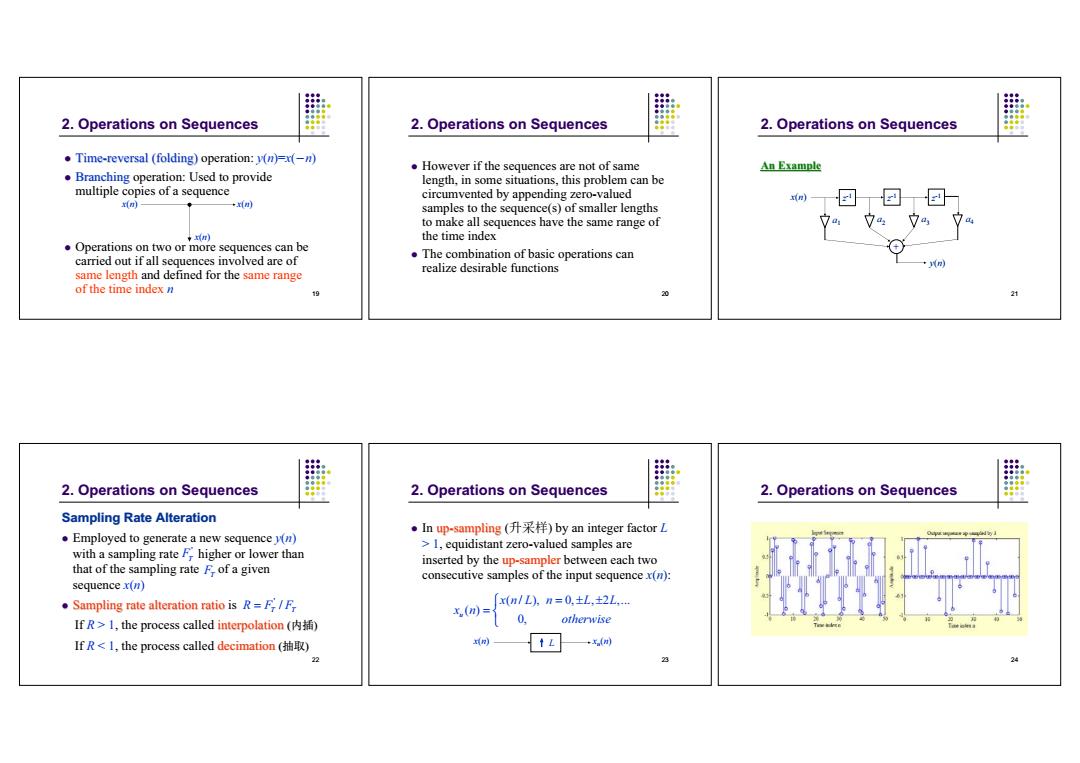正在加载图片...

2.Operations on Sequences 2.Operations on Sequences 2.Operations on Sequences Time-reversal (folding)operation:y(n)=x(-n) However if the sequences are not of same An Example Branching operation:Used to provide length,in some situations,this problem can be multiple copies of a sequence circumvented by appending zero-valued dn) + 回回回 samples to the sequence(s)of smaller lengths to make all sequences have the same range of a the time index Operations on two or more sequences can be carried out if all sequences involved are of The combination of basic operations can same length and defined for the same range realize desirable functions of the time index n 19 20 21 2.Operations on Sequences 2.Operations on Sequences 2.Operations on Sequences Sampling Rate Alteration ·Inup-sampling(升采样)by an integer factorL Employed to generate a new sequence wn) >1,equidistant zero-valued samples are with a sampling rate F higher or lower than inserted by the up-sampler between each two that of the sampling rate F of a given consecutive samples of the input sequence x(n): sequence x(n) Sampling rate alteration ratio is R=F/F x(n/L),n=0,±L,±2L. x(m)= IfR>l,the process called interpolation(内插) 0 otherwise IfR<l,the process called decimation(抽取) 同) t L →x( 2219 2. Operations on Sequences Time-reversal (folding) reversal (folding) operation: y(n)=x(ˉn) Branching operation: Used to provide multiple copies of a sequence Operations on two or more sequences can be carried out if all sequences involved are of same length and defined for the same range of the time index n x(n) x(n) x(n) 20 2. Operations on Sequences However if the sequences are not of same length, in some situations, this problem can be circumvented by appending zero-valued samples to the sequence(s) of smaller lengths to make all sequences have the same range of the time index The combination of basic operations can realize desirable functions 21 2. Operations on Sequences An Example z-1 a1 z-1 a2 z-1 a3 a4 + y(n) x(n) 22 2. Operations on Sequences Sampling Rate Alteration Employed to generate a new sequence y(n) with a sampling rate higher or lower than that of the sampling rate of a given sequence x(n) Sampling rate alteration ratio is If R > 1, the process called interpolation (ᨂ) If R < 1, the process called decimation (ᣭਆ) ' FT FT ' / RFF T T 23 2. Operations on Sequences In up-sampling (ॷ䟷ṧ) by an integer factor L > 1, equidistant zero-valued samples are inserted by the up-sampler sampler between each two consecutive samples of the input sequence x(n): ( / ), 0, , 2 ,... ( ) 0, u x nL n L L x n otherwise x(n) Ė L xu(n) 24 2. Operations on Sequences�����������